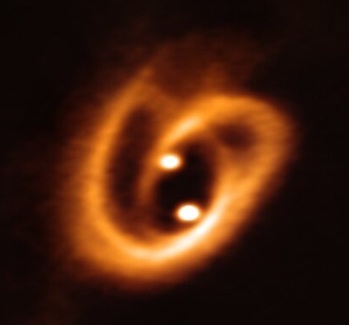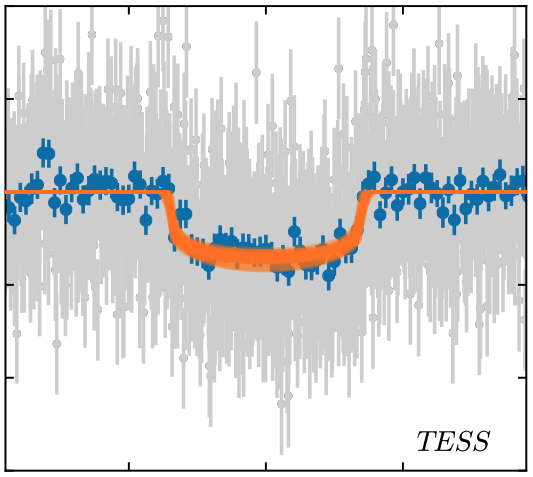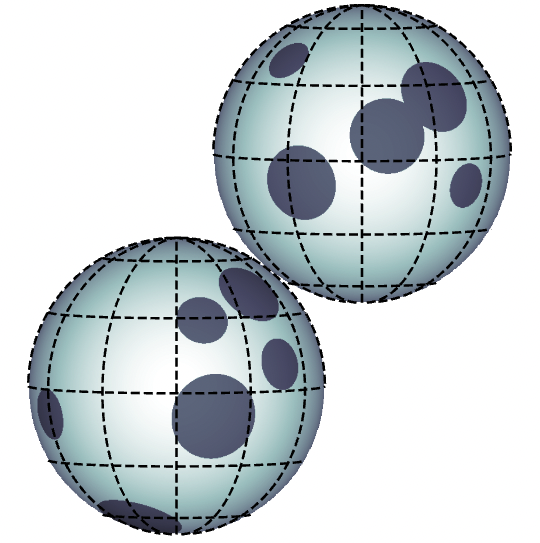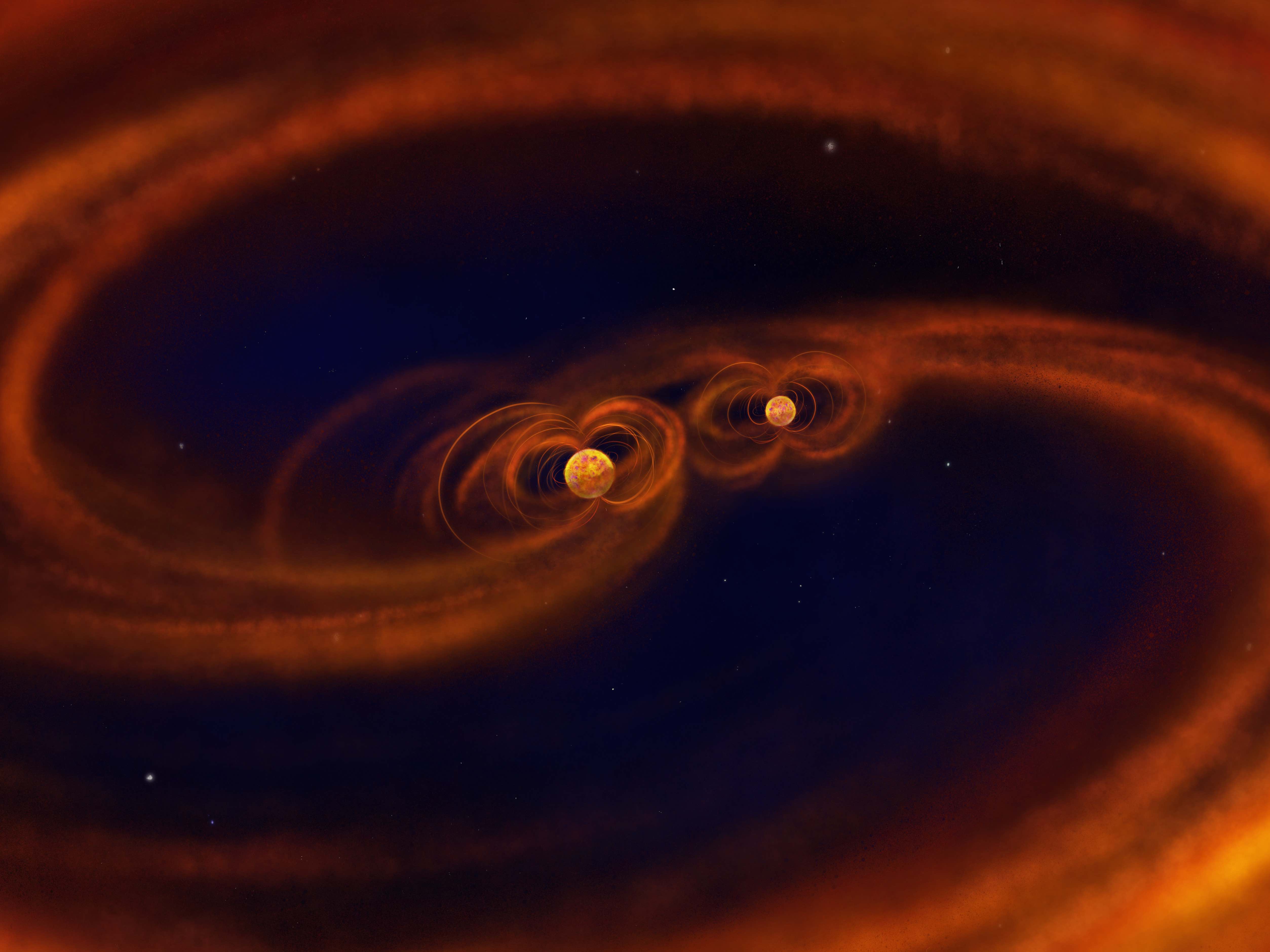Program Summaries
Overview
I have a few primary research threads and a lot of fun side projects. Here are brief overviews to help guide your exploration of my research portfolio.
Planet Formation in the Binary Environment
 Binary star systems pose challenges to planet formation. If the binary separation is smaller than the typical size of a protoplanetary disk, the binary orbit will dynamically truncate or disrupt the reservoir of material from which planets form. The community has found planets in binary systems of all separations, but planets in close binaries are rare. The goal of this research thread is to probe the dynamical interaction between the binary orbit and circumstellar disks. We also hope to identify the ingredients that allow some close binaries to form planets while other do not.
Binary star systems pose challenges to planet formation. If the binary separation is smaller than the typical size of a protoplanetary disk, the binary orbit will dynamically truncate or disrupt the reservoir of material from which planets form. The community has found planets in binary systems of all separations, but planets in close binaries are rare. The goal of this research thread is to probe the dynamical interaction between the binary orbit and circumstellar disks. We also hope to identify the ingredients that allow some close binaries to form planets while other do not.
The TESS Hunt for Young and Maturing Exoplanets (THYME)
 Planets evolve over the first billion years of their lives. This evolution imprints intriguing features on the population of mature exoplanets (e.g., the exoplanet radius valley). We are trying to find young planets as they traverse this formative era to determine the dominate physical processes that shape their evolution. We do this by identifying transits in the light curves of young stars from the TESS mission. We’ve found lots of them! I’m primarily interested in using Gaia to find the stellar siblings of these planetary systems. Precise age measurements are required to make our discoveries “benchmark” systems, and this is made much easier if we can establish a collection of coeval (same age) stars.
Planets evolve over the first billion years of their lives. This evolution imprints intriguing features on the population of mature exoplanets (e.g., the exoplanet radius valley). We are trying to find young planets as they traverse this formative era to determine the dominate physical processes that shape their evolution. We do this by identifying transits in the light curves of young stars from the TESS mission. We’ve found lots of them! I’m primarily interested in using Gaia to find the stellar siblings of these planetary systems. Precise age measurements are required to make our discoveries “benchmark” systems, and this is made much easier if we can establish a collection of coeval (same age) stars.
Characterizing Young Eclipsing Binaries
 Eclipsing binaries are our best laboratories to measure the fundamental properties of stars, their masses and radii. In this thread of research, I am seeking to characterizing a sample of young eclipsing binaries of various masses and ages. Filling in this sparsely populated parameter space, I hope to develop a precise empirical relation that will allow for more accurate measurements of exoplanets around young stars, and to inform the next generation of stellar evolution models. A large component of this work is to understand the effect of star spots on our observations and how they may be biasing our measurements of young stars (and the planets around them!).
Eclipsing binaries are our best laboratories to measure the fundamental properties of stars, their masses and radii. In this thread of research, I am seeking to characterizing a sample of young eclipsing binaries of various masses and ages. Filling in this sparsely populated parameter space, I hope to develop a precise empirical relation that will allow for more accurate measurements of exoplanets around young stars, and to inform the next generation of stellar evolution models. A large component of this work is to understand the effect of star spots on our observations and how they may be biasing our measurements of young stars (and the planets around them!).
Accretion in Short-Period Binary Systems
 Accretion, the process by which an object gains mass, is a critical component in the story of star formation. After their initial assembly, stars accrete material from a protoplanetary disk. This interaction is complex, but it caries important implications for the eventual properties of the star and its planets. Short-period binaries have a completely distinct disk interaction in which they periodically pull material in from a circumbinary disk. Observers and theorists alike are fascinated with these systems because they represent unique dynamical laboratories where we can test (magneto-)hydrodynamic theory in astrophysical settings on human (graduate student) time scales. Observing this binary-disk interaction was the focus of my Ph.D. thesis.
Accretion, the process by which an object gains mass, is a critical component in the story of star formation. After their initial assembly, stars accrete material from a protoplanetary disk. This interaction is complex, but it caries important implications for the eventual properties of the star and its planets. Short-period binaries have a completely distinct disk interaction in which they periodically pull material in from a circumbinary disk. Observers and theorists alike are fascinated with these systems because they represent unique dynamical laboratories where we can test (magneto-)hydrodynamic theory in astrophysical settings on human (graduate student) time scales. Observing this binary-disk interaction was the focus of my Ph.D. thesis.
Other Research
I’ve been lucky to work on many different projects during my research career. These projects have been both theory and observation based, making use of data sets spanning the X-ray to near-infrared. The links below provide a brief summary of the projects I have led:
Studying the Membership and Binary Populations of Open Clusters
X-ray Spectroscopy of Recurrent Novae
Optical and Near-Infrared, Time-Series Photometry of Stellar Flares
Analysis of the Column Density Distribution of Simulated MHD Turbulence
